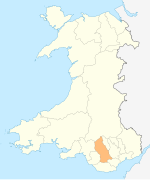Llanilid
| Llanilid | |
|---|---|
 The church of St Ilid & St Curig | |
Location within Rhondda Cynon Taf | |
| OS grid reference | SS978814 |
| Principal area | |
| Preserved county | |
| Country | Wales |
| Sovereign state | United Kingdom |
| Post town | Pontyclun |
| Postcode district | CF72 |
| Dialling code | 01443 |
| Police | South Wales |
| Fire | South Wales |
| Ambulance | Welsh |
Ogmore | |
Llanilid is a small settlement of in the county borough of Rhondda Cynon Taf, Wales. It is in the historic county of Glamorgan. Llanilid is part of the community of Llanharan along with the villages of Bryncae, Brynna, Ynysmaerdy, Peterston-super-Montem and Llanharan itself.[1]
History
Since the time of the
Little is known of the early history of Llanilid after the end of Norman control, though it is known the region boasted an ancient church, a smithy and several displaced small holdings. Most of the farms dealt with livestock, with only the western area of Llanilid, in modern times known as Felindre, possessing fertile land.
Llanilid remained a rural parish throughout the 18th and 19th century, though with the coming of the industrialisation of South Wales its northern border was transformed by a large opencast mine. In 1848 Sophia Crichton-Stuart, Marchioness of Bute, wrote to her land agent, expressing concern at the actions of the Earl of Cottenham, then Lord Chancellor, who had the patronage of the parish, "where hardly anyone speaks English", for appointing as rector "a man without Welsh".[10] Despite the changes, the hamlet saw little growth or additional housing and in 1961 the population was 95.[11]
Etymology
According to Thomas Morgan, Llanilid follows the tradition of Welsh place names attached to a parish in taking its title from the dedicated saint of the local church. In Llanilid the local church is St. Ilid & St Curig's church, and Morgan states that this relates to Ilid a person who introduced Wales to Christianity in the 1st century. This research may be connected to that of famed literary forger
Major landmarks
With a sparse population and made up mainly of farm houses, Llanilid still contains several buildings and structures of note. Arguably the oldest recognised structure in Llanilid is the Castle
In 2005, work started on a major film studio on the northern borders of Llanilid, named Dragon International Film Studios. The £330m development saw its first major international film, Ironclad released in 2009.[18][19]
Notes
- ^ Davies (2008) p.500
- ^ a b c d Williams (1971), p.206
- ^ Davies (2008) p.492
- ^ "Llanilid". genuki.org.uk. Retrieved 1 September 2013.
- ^ Royal Commission on Ancient and Historical Monuments in Wales (1976) p.4
- ^ Royal Commission on Ancient and Historical Monuments in Wales (1976) p.5
- ^ a b c Williams (1971), p.208
- ^ a b c Williams (1971), p.209
- ^ Williams (1971), p.210
- OCLC 731224268.
- ^ Williams (1971), p.211
- ^ Morgan, Thomas (1912). The Place Names of Wales (2 ed.). Newport: J.E. Southall. p. 185.
- ^ a b Fenn, R.W.D. (1962). "The Saints in the Vale". In Stewart Williams (ed.). Vale of Glamorgan Series. Vol. IV: Saints and Sailing Ships. Cowbridge: D Brown & Sons. p. 119.
- ^ ISBN 0140710566.
- ^ "Llanilid Castle-ringwork (300098)". Coflein. RCAHMW. Retrieved 26 October 2021.
- National Historic Assets of Wales. Retrieved 26 October 2021.
- ^ "Llanharan". rhondda-cynon-taff.gov.uk. Retrieved 30 August 2013.
- ^ "Curtain up on Valleywood studios". bbc.co.uk. 20 July 2005. Retrieved 29 August 2013.
- ^ Smith, Mark (10 March 2011). "Medieval movie heralds Valleywood's first release". walesonline.co.uk. Retrieved 1 September 2013.
Bibliography
- ISBN 978-0-7083-1953-6.
- Francis, David J. (1971). "A brief account of three parishes". In Stewart Williams (ed.). Glamorgan Historian. Vol. VII. Cowbridge: D Brown and sons.
- Witts, T.J. (1988). The Forgotten Years, Volume 2; a history of Llanharan and district. Llanharan: Diary Publishing. ISBN 1-871691-00-1.
- Royal Commission on Ancient and Historical Monuments in Wales (1976). An Inventory of the Ancient Monuments in Glamorgan. Royal Commission on Ancient and Historical Monuments in Wales. ISBN 9780117011410.


